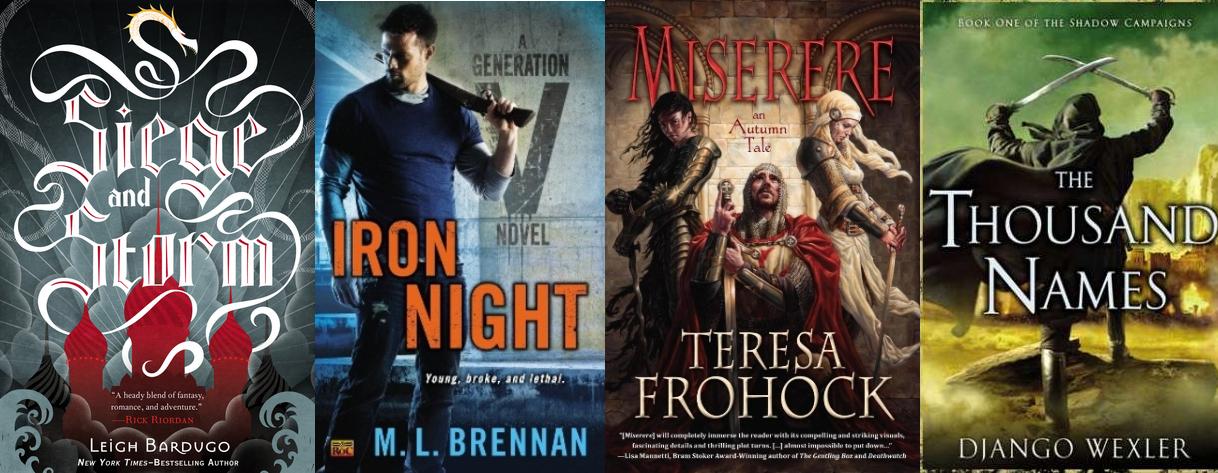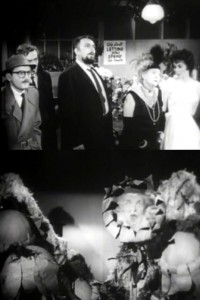Author Chat, Round Two
Excited to bring you the second round of Author Chat with ML Brennan, Leigh Bardugo, Teresa Frohock, and myself! The first round, along with ML’s explanation of her inspiration, are over on her site, take a look.
UPDATE: Round Three is up on Teresa’s blog!
Round Four is up on Leigh’s Tumblr!
Q: Is there an element you put in your books not because it was necessary to the plot or characters, but just because it was awesome?
Django Wexler: I’m a big fan of history and using historical details, especially in fantasy. In my adult series, that’s more or less the focus of the books, so it doesn’t really qualify for this question, but there’s some fun stuff in my kid’s book, The Forbidden Library. It takes place in 1931, but the majority of it happens in various magical domains, so the real world isn’t mentioned that often. I did my best to sneak in various accurate details (events in the newspapers, buildings in the cities, new inventions, and so on); they probably won’t stick out to most readers, but having them in there makes me happy. I’m working on the second book now, and there’s a flashback that takes place in Central Park, so I had to go and look up some histories to see what that was like at the time. (A dump, it turns out. LaGuardia’s big cleanup of the park didn’t start till 1934.)
Teresa Frohock: Definitely the Rosa. The whole concept of a sentient plant was my little nod to Roger Corman’s 1960 movie The Little Shop of Horrors. The black comedy had me totally unprepared for the ending when the flowers on Audrey Junior bloom into the faces of all the people Seymour had murdered. I don’t know why those final images horrified me so much. By today’s standards, the special effects were cheap and silly, but my young mind filled in all the blanks. To this day, I can remember that final scene when Audrey Junior blooms and I got a chill that made me shudder.
I wanted to twist on Audrey Junior and give the plant a purpose, hence the Rosa. I think the Rosa and the Wasteland were some of my favorite parts of world building for Woerld. A lot of fantasy novels have people engage in working magic with no repercussions. I wanted a nuclear holocaust of a magic war. I imaged that the residual effect of the spells would long outlast the war.
Leigh Bardugo: I like imagining Teresa setting fire to the world. In Siege and Storm, Alina discovers that Mal has been spending his nights brawling in what started out as an ordinary fight club scene because, well, I wanted to write about a fight club. But my friend Sarah called me out on it. She basically said, “What is this Far and Away shiz?” And I knew she was right, but I also knew there was a reason beyond bare-knuckle shenans for why I felt so attached to the scene. It was only on the rewrite that I realized the change I needed to make to give the moment significance: Mal is an ordinary soldier and he needed to be challenging Grisha, the members of the magical elite. He’s doing it to prove he isn’t helpless, to get a bit of his own back—and it ended up having an impact not only on his character, but on the rest of the trilogy.
I desperately, desperately wanted Sturmhond to have a sky fortress in Siege and Storm. I had this whole vision of how it would plummet to the earth in this big battle. But with the rules I’d created for the magical system, it was impossible. In theory, a group of Squallers could have kept a floating fortress aloft and stable, but in the context of my world it would have been an absurd expenditure of resources, completely pointless. So that was the end of the sky fortress. But I still think of it fondly.
ML Brennan: The first rule of Grisha Fight Club is – don’t talk about Grisha Fight Club. (because if you do, Teresa will totally set off magical nukes)
I usually start every book with a stack of post-it notes with ideas that I’ve come up with that I’m in love with, and the challenge is to try to figure out how to find a place to put them that actually works with the plot.
I think my favorite one in Generation V was about body disposal. When I was researching the kitsune mythos for the book I read a number of very fun stories and legends that referenced the ability of kitsune to trick the humans around them by changing their perceptions of situations and sometimes outright forcing hallucinations. I wrote in some limits, and popped it in. I honestly wasn’t expecting to use it that often – until I wrote my first fight scene. It ends with a body on the ground – the body of a very non-human individual that is also covered in fox bite-marks, bullet holes, and some brick smashing. (oh, it was a fun fight) And my first thought was, “Wait a second – this guy is going to end up on some medical examiner’s slab. This vampire secret is going to get out fast.” That was a problem – except that I had the kitsune’s ability to alter perception under controlled conditions. So suddenly I got to not only discover a whole new application for the kitsune magic, but I also appeased my inner anal-retentive nitpicker for why the hell the average Providence detective didn’t call the FBI crime lab about this strange and inhuman body. And it becomes this huge multiple-page explanation and layout, for really such a minor issue (I mean, I guess I could’ve left the body in a trash bin and bothered no one but myself), but I became absolutely wrapped up in the execution and limitations – and mostly because I thought it was pretty cool.
I’d wanted the kitsune to have a very special and specific kind of magic, but I’ve actually found it coming up handy in multiple places over the books. So something that at the time I thought I was kind of indulging myself in turned out to be extremely useful.
Q: How do you go about your world-building – is there a particular process? Characters and plot first, or world first?

Django Wexler: I am definitely a “plot and characters first” person most of the time; at least, that’s my most successful strategy. I tend to have a character with an arc and a vague idea of what that character should do, and then I start thinking about the world and what would make that possible. In The Thousand Names, I knew I wanted a general who could do clever things with Napoleonic-style combat – that implies both a certain tech level and a magic system that’s not so overwhelming and omnipresent that it changes the way warfare works, and I built up the rest of the world from those fixed points.
The Forbidden Library was also built around the characters. I knew the basic relationship was going to be a heroine and her Merlin/Gandalf/Dumbledore figure, who tells her she’s the Chosen One, with the point of the story being whether or not she can trust what he says. I also had this idea of a magical, infinite library (this is a pretty common fantasy for people like me, I think, we all want to live in one) so I constructed a magic system based around printed words. And THAT restricted where I could be, time-wise, because a magic system based on the printed word is going to get very strange when you introduce it to photocopying and the internet!
In my Idea File there are a few proto-novels that are basically just a setting, without a plot or characters. That’s usually an indication that they’re not quite “baked”, and need some more work before I can really get started on them.
Teresa Frohock: If this were a con, I’d just point at Django and say, what he said. I do the same thing.
My stories always begin with a character. Lucian came from this cool dream that I had. I dreamt of a tall, Slavic man with long dark hair; he walked with a limp and a cane through this fantastical city. He was dressed in medieval clothing, and he was talking to a young boy dressed in 20th century clothing. Then the dream shifted, as dreams often do, and I saw a forest. Nailed to a tree was a sign that read: JESUS SAVES. Across a small path was the bumper of an older model car that had a bumper sticker on it that read: NOBODY SAVES YOU MORE THAN WINN DIXIE.
Believe it or not, Miserere and Woerld kind of grew out of that.
The Garden grew around Guillermo’s character and his past (and past lives). [Why, yes, that was a pun. You’re welcome.] Whenever I’m writing a scene and realize that I need an explanation for something, I create that aspect of the world.
I keep it all straight by using a series sheet along with my synopsis. My synopsis shows me the trajectory of my protagonist’s story, and my series sheet helps me keep up with names and spelling, in addition to details about the world. I think Miserere’s series sheet was around seven pages long. That’s not counting all of the really cool articles and maps that I collected while working on it. The world building for Miserere takes up three 3″ binders and another file that holds oversized materials such a maps.
The world building for Garden was just as intense, and it never feels like work. I love about reading history, philosophy, folk and fairy tales, and religion. I really enjoy twisting these elements into my worlds, but the world building, for me, always begins with a character, then I build their world around them.
Leigh Bardugo: Seriously, can’t we make someone put us all on a panel? I’m not above bribery.
I don’t have much to add to what Teresa and Django said. When I talk about worldbuilding I like to break it down into sense of order (how power functions in the world—political, personal, magical), and sense of place (the texture of the world—food, clothing, architecture). But these get tangled up pretty quickly and they should.
Shadow and Bone began with the question, “What if darkness was a place?” I wanted to take something that usually functions as a metaphor in fantasy and make it literal. That idea became the Unsea and everything else grew out of that—the Darkling’s power, Alina’s power, the idea of a country kept in an economic stranglehold by a geographical aberration. But when I got into research (cultural histories, recipes, textiles, folklore), it had a huge impact not just on the feel of the world, but also on the plot and characters. For example, Alina and Mal had parents in my first draft. But by the time I started the second draft, they were orphans, and that was the direct result of reading I’d done on the Napoleonic Wars and the roots of the Decembrist Revolt. I’ve learned to just accept that I have no idea what I’ll use or where inspiration may come from, and to try to stay flexible.
ML Brennan: Well, I could host a con in my living room and put all of us on a panel, but I don’t think I’d be able to issue more than a dozen badges, and it might have to be a potluck.
I start with world first – Generation V began as a kind of thought-experiment about how I could create vampires that functioned as a species (and that also solved that pesky population explosion issue). It wasn’t until I’d completely built the vampires (much research was done into parasites!) that I started actually thinking about characters. But I actually agree with Django’s comment about a world not being “baked” yet at that phase. I’d constructed a perfectly interesting idea, but it wasn’t until I started working on characters and developed my protagonist, Fortitude, that the world started getting interesting. The moment you have a real character, they start pushing around the world and having desires and motivations and conflict – and things take off.
And then you have to design more world because all of a sudden things are getting pushed around. So I’d say that characters are kind of my midpoint in construction. I have to build enough world to feel comfortable and confident – and then I introduce the characters and everything gets exciting. I think the characters also show where weak parts in the world construction are, so then you can bring in more elements and finish things off.
That’s all for now, but stay tuned for more chat next week!


